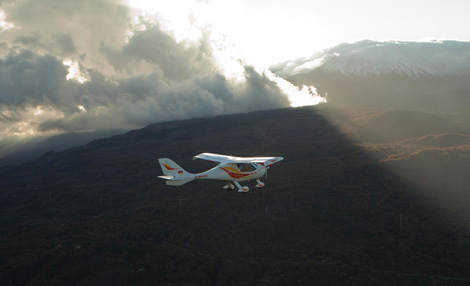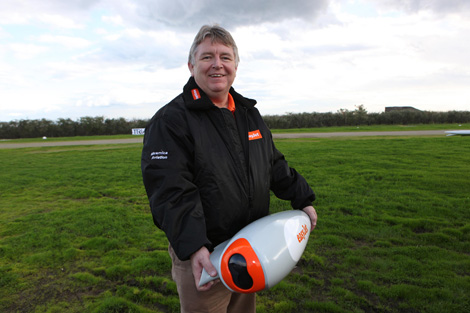Scott Carey travelled to Sicily to observe Easyjet and Nicarnica Aviation’s successful test flights of the pioneering AVOID ash cloud detection system.
Easyjet invited over forty British and international journalists to board helicopters at a tiny airstrip in Catania, Sicily to observe the final days testing of its Airborne Volcanic Object Imaging Detector (AVOID) system.
This was the culmination of two weeks of testing in Sicily where a specially fitted Flight Design CT microlight aircraft has flown more than 30 hours over Mount Etna, the most active volcano in Europe, as well as the nearby volcanic island of Stromboli.
AVOID is a wing mounted tactical awareness device for providing real-time imagery of hazards ahead of a jet aircraft.
Information is supplied to the cockpit from two fast-sampling, imaging infrared cameras that can detect hazardous volcanic ash particles in the airspace up to 100km ahead of the aircraft, day or night, so that the flight path can be adjusted, much in the same way that weather radars operate. Information is also communicated to ground control to allow other aircrafts to avoid the ash clouds.

The inventor of the AVOID system, and technical director of Nicarnica Aviation Dr Fred Prata was inspired to develop the technology by the story of KLM flight 867, the B747 aircraft which momentarily lost all four engines while travelling over Alaska due to volcanic ash.
Volcanic ash becomes a threat to jet engines when particles enter the engine, heat up and solidify as glassy deposits which can prevent the engine from operating. The economic damage of this to KLM flight 867 amounted to around US$80 million and it is “this kind of thing that we are trying to avoid with this new technology,” said Dr Prata.
Head of engineering at Easyjet Ian Davies (below) said that the carrier initially plans to fit ten of its own aircraft at a cost that will climb into the “tens of millions of pounds [...] but we believe that’s money well spent.” Davies added that the more aircrafts fitted with AVOID technology, the better ground control will be able to map future ash clouds.
Despite the success of these initial tests and the general feeling of optimism around the Easyjet and Nicarnica camp the technology still needs to be tested on faster, commercial aircrafts, and must be approved by the relevant aviation bodies.
“The plan is to fly it faster, higher and in low visibility” where “the system will really show its talents,” according to Dr Prata. He said that it is important to test “areas where there was not ash,” in order to keep the risk of false detection as low as possible, adding that no test has resulted in a false detection so far.
Both parties hope to conduct further tests with Airbus on board an A340 aircraft at 30,000ft in order to reach its potential range of 100km. The technology will then be put through the certification process with the European Aviation Safety Agency (EASA) ready for installation by the end of 2012.

One thing that was made very clear on the day is that the threat of widespread disruption to the aviation industry and airline passengers from another volcanic eruption is imminent.
The Icelandic volcano Katla, located alongside the Eyjafjallajokull volcano which caused widespread travel disruption and cost Easyjet around £50million in 2010, is widely seen as overdue an eruption, with Icelandic volcanologists closely monitoring the recently increased seismic activity.
Analysis by Dr Prata and the Norweigan Institute of Air Research (NILU) of the 2010 eruption suggests that the level of disruption could have been avoided.
By combining the infrared data downloaded from the European geostationary satellite system SEVIRI with a state-of-the-art atmospheric dispersion model it was deduced that over the entire period of the eruption at Eyjafjallajokull only two percent of the airspace had ash in it at concentrations which could not be flown through. Davies believes that with AVOID the remaining 98 percent of airspace could have been kept open to air traffic.
Other airlines are believed to be looking into ash cloud detection systems of their own.
For more information visit easyjet.com.
Scott Carey
Here is a computer generation of how the technology will work in practice:








